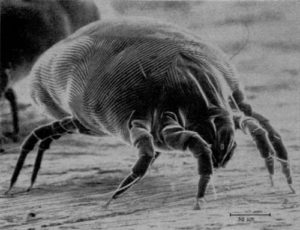Table of Contents
Dust mites are a common problem in most households around the world. While dust mites don’t bite, can these microscopic creatures cause skin rashes? If so, what can you do about the rashes caused by dust mites?
I’ve been dealing with dust mites infestation for more than a year. It was my son who’s suffering the worse of it. What started as slight discomfort in the eyes turned out to be a full-blown dust mites allergy.
Before we deal with the effect of dust mites on skin-related issues, let’s take a glance on these unwanted companions in our home.
Dust Mites Facts

Dust mites belong to the same family as spiders. This means that these creatures have eight legs. Dust mites escaped bare human eyes. An adult dust mite measures about 0.3 millimeters or 0.01 inches.
These tiny pests thrive in a warm and humid environment. Specifically, dust mites grow in temperature between 20°C to 25°C (68 to 77 Fahrenheit) and humidity between 70% to 90%.
There’s an urban myth that goes around dust mites feasting on human skin. The truth is, dust mites don’t bite on human but they feed on dead skin cells shed off from our body. Often the flakes of skin cell accumulate at certain areas in our home and become consistent food supply for dust mites.
How Do You Know If You Have Dust Mites At Home?
Often, humans co-exist with dust mites without being aware of their presence. As you can’t detect dust mites from plain sight, you can’t know for sure if there are dust mites in your home. Statistically, dust mites are very common in most households, including in the US.
You’ll only start noticing the presence of dust mites in your home when you or family members start showing signs of allergy. Dust mites allergy often manifest in symptoms like teary eyes, irritated throat, runny nose, sneezing, and coughing.
When left untreated, the symptoms can get worse quickly and you may start experiencing nasal inflammation. As the inner passage of your nose swell, you’ll find breathing becomes harder. Dust mites allergy may cause asthma in children or aggravate symptoms on individuals who are suffering from it.
Can Dust Mites Cause Skin Rashes?

The reason behind dust mites allergy isn’t the creature itself, but rather the protein found in dust mites carcasses and excretion. The protein becomes an allergen that triggers allergic reaction from our body.
In rare cases, some individuals may exhibit red and itchy rashes as the skin is exposed to dust mites allergens. If you’re suffering from eczema, you’ll find that the condition on your skin aggravates. For instance, the affected parts on my skin on my knuckles start cracking when exposed to dust mites allergen.
Treatment For Skin Rashes Caused By Dust Mites
If you suspect that you’re developing skin rashes due to dust mites, do check out with your doctor immediately. That’s because dust mites allergy can escalate into multiple symptoms and worsen quickly.
Depending on the condition on your skin, your doctor may prescribe medications such as anti-histamine, which reduces the allergic reaction. Other forms of medications may also be given depending on other dust mites allergy symptoms you may have.
You’ll eventually recover after taking or applying the medications given. However, if your home continue to be infested with dust mites, you’ll experience repeating symptoms as the effect of the medicine fades.
How To Get Rid Of Dust Mites In Your Home
Getting prescriptions from the doctor helps to address skin rashes and other symptoms caused by dust mites in the short term. But to manage the condition in the long term, you’ll need to get rid of dust mites in your home.
To be realistic, you can’t ensure that your home is totally free of dust mites. But you can reduce dust mites population to a level where you don’t suffer from the allergy symptoms.
Here are what you can do to reduce dust mites at home.
1. Clean Beddings
The common suspect of dust mites present in the bedroom, where you spend an average of 8 hours sleeping on the bed. You’ll want to clean the beddings at least once a week if you have serious allergic symptoms.
Alternatively, you can opt for hypoallergenic mattress and pillows, which prevent dust mites from getting into the beddings.
2. Reduce Humidity
If you’re feeling stuffy at home, chances are, the humidity is on the high side and ideal for dust mites. To reduce humidity, you need to ensure that your home is properly ventilated. Else, you can install a portable dehumidifier which will remove excess moisture in the air.
3. Clean Your Home Regularly
Besides the bedroom, you’ll want to pay attention to other areas of your home that may potentially be breeding spots for dust mites. For example, having a carpet is an open invitation for dust mites to grow. Clean the carpet regularly to prevent dust mites from growing.
Stuffed toys, upholstery and areas that trapped dust easily are also potential hiding spots for dust mites. Make sure they are part of your cleaning routine.
4. Use Natural Dust Mite Sprays
It’s tempted to use chemical-based solution to get rid of dust mites. But considering the impact on the environment and health, it’s better to opt for natural dust mite sprays. You can use the sprays when cleaning your home to kill dust mites on the mattress, couch, and other surfaces.
Check out more natural ways to kill dust mites in this article.
Final Thoughts
Whether it’s skin rashes or other dust mites allergy symptoms, you’ll want to take dust mites seriously. These creatures can grow rapidly and affect the well-being of you and your family. Preventing dust mites grow is ultimately better than suffering from the symptoms.
Have you experienced skin rashes from dust mites? What did you do to alleviate your symptoms?
Related:
- 9 Dust Mite Control Products That Work
- How To Get Rid Of Dust Mites In The Couch (7 Ways)
- Natural Essential Oils That Kill Dust Mites
- How To Reduce Humidity In The House (13 Ways)
- How To Get Rid Of Dust Mites From Your Skin




Hi Kenny,
Thank you for writing this article, it was most informative. I sometimes get these symptoms at home. I thought it was an allergy to the dust itself, or maybe my cat, but now after reading this I see it may be the dust mites. Do you know if animals can have this allergy? My cat gets these symptoms too, and the vets haven’t been able to work out what he is allergic to.
Many thanks,
Natalie.
Hi Natalie,
Apparently, cats and dogs may suffer from dust mites allergies. Hope your cat gets well soon.
Cheers,
Kenny